Here’s Why You Need Hot Essential Oils (the Spice Oils!)
The hot essential oils correspond to the ‘fire’ type of oils. The body organ that reflect them would be the stomach (as they are directly related to our digestion).
The Top Hot Essential Oils: Spicy!
Some of the links on this page are affiliate links which means I will receive a commission if you purchase through them. This will not cost you and will help me keep learning and improving my skills in order to be able to write the best information I can on this site. I use my own information as reference guide to make my essential oils blends and natural skincare. Thank you.
Very high in antioxidants, hot essential oils (or spice essential oils) are an incredibly important group of essential oils. I’ve already written about respiratory congestion essential oils (eucalyptus, pine, spruce, fir and juniper) and immune boosting essential oils (tea tree, niaouli and ravensara) so here we’ll cover the hot essential oils so you can learn about the different essential oil groups. The hot oils are, in fact, a large group of oils with great diversity in terms of botanical origins, toxicity and particular function as well as benefits.
Why Trust My Advice?
I own 2 full essential oils kits and half a ‘rare and more expensive’ oils kit (in total around 300 different essential oils) which I use in different ways. Even though I’m not a professional aromatherapist I do keep updating my knowledge, skills and expertise on a regular basis with certified courses on an on-going basis (check my about me page). I understand how difficult it is to find trustworthy advice online when it comes to the natural healthcare topic and I actually built Oh Mighty Health so I could use it as a reference site for myself. I live the natural lifestyle as well as I can and I take my own guides very seriously! Here are some reasons why you can trust my advice:
- I learn from the best courses and teachers around (Europe and US) and keep this current, which is paramount for me.
- I use my website as a directory and incredibly helpful guide/source for my own formulas and DIY blends.
- I keep in touch with all kind of suppliers and travel far to purchase some of my natural products. I’m VERY PICKY when it comes to essential oils and natural skincare ingredients.
- I keep revisiting my posts and updating relevant information.
Ok, with that out of the way, let’s just dive into the topic, shall we?
Choosing the Perfect Hot Essential Oils Mini-Kit
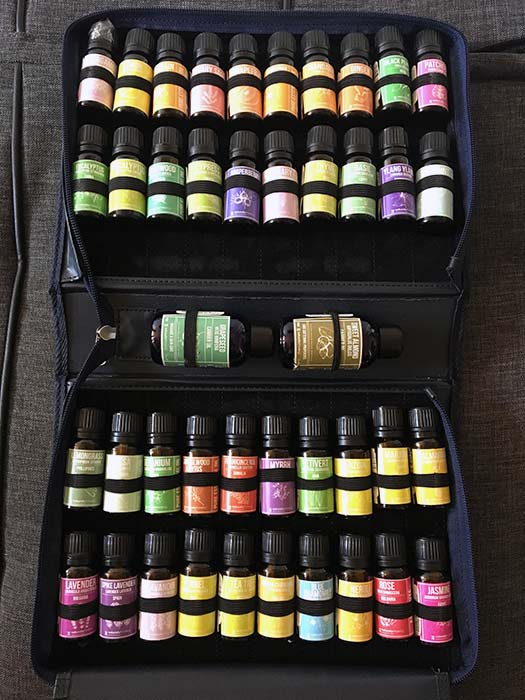
There are many hot essential oils (there’s a complete list at the end of the article) but I think that you only need a few oils per group of oils (respiratory oils, immune system oils, floral oils, spice/hot oils, etc).
I’ve chosen hot oils that will be enough for you to get your perfect hot oils mini-kit going. Each oil will be covered individually in this article so you learn how it can benefit you when used on its own and also when used as part of a blend.
What are hot essential oils? The hot oils can be classified into 2 categories (by the way, some of these hot oils are considered warm oils):
1. EXOTIC SPICES OILS – Referring to hot and mild spices like cardamom pod, clove bud, ginger root, black pepper [a fruit], allspice [a berry], nutmeg [a seed], cinnamon bark, etc – These essential oils are usually linked to India. In this post I’ll be covering the following essential ones like:
- Cinnamon [get here] (different to Cassia essential oil)
- Ginger [get here]
- Clove [get here]
- Cardamom [get here]
2. COMMON KITCHEN SPICES OILS – Not hot. These are referring to aromatic herbs, i.e. thyme, rosemary, coriander, oregano, basil, sage, etc – These essential oils are usually linked to the Mediterranean area. Again, these are not hot! I’ll be covering the following essential oils:
Both exotic hot and warm spices as well as the herbal kitchen spices essential oils are incredibly powerful and beneficial when it comes to their medicinal value in terms of fighting microbes (remember these plants have been used to preserve food. Here’s an article from ResearchGate on using these oils for food preservation). This makes them incredibly valuable.
CAUTION
Spice essential oils (common kitchen spices [herbs] as well as the more exotic spices like ginger or cardamom) generally have really high dermo-toxicity and you need be VERY careful when using them. You could say they possess the hightest dermo-toxicity potential out of all essential oils.
What Are Hot Essential Oils?
Just so we’re clear, what are hot essential oils? We’ve seen a way to categorise them above but I think it is important to understand that hot essential oils correspond to the ‘fire’ type essential oils (they have a direct link with our stomach which obviously relates to our digestive system). These oils will aid in supporting our digestive system (ingestion of food) and stomach wellbeing in general. The ‘fire’ element in them is directly linked with the acid in our stomach.

In fact, a great way to use these are in their plant form (as part of your herbs and spices arsenal in your kitchen pharmacy). Why? These are EXTREMELY dermotoxic oils, difficult to use, and you would have to be extra careful when using them.
Some of the hot oils are milder and considered ‘warm oils’. When you go through each individual oil below you’ll be able to distinguish the hot from the warm oils easily.
A Note on Safety – Being Careful with Hot Essential Oils
Out of all essential oils, the spices (hot oils) are the ones you want to be most careful of. They can irritate the skin and produce a burning sensation so essential oil safety here is a MUST. If you have sensitive skin you should avoid using any of these oils before checking with a doctor, dermatologist, aromatherapist, etc .
A WORD OF CAUTION WITH THESE OILS
These essential oils are considered to be high regarding their dermo-toxicity and you need be VERY careful when using them. You could say they possess the hightest dermo-toxicity potential out of all essential oils! Just a tiny bit of these oils can cause irritation and burning sensation when applied directly to the skin.
DO NOT TAKE THESE OILS INTERNALLY!!
If you’d like to benefit from their properties and want to take internally as opposed to topically just use the plant instead of the essential oil (i.e. cook with cardamom pods instead of using cardamom essential oil or drink ginger tea instead of using ginger essential oil).
General Function and Healing Values of the Hot Oils
Hot essential oils can heat the digestive system (enhancing the digesting function when there’s food intake) and stimulate our metabolism. These oils are connected to the fire element. When it comes to health, they can be used to activate our system in the winter time, for example.
In a nutshell, simply remember that the spice essential oils heat and stimulate. These are activating warm oils that heat the digestive track, enhancing the digestive function and really, really good at stimulating our metabolism. This means they can also help to stimulate our glands (sweat), blood circulation, etc. Once again, these oils heat the body and stimulate the metabolism.
Application of the Oils
KITCHEN MEDICINE – High dermotoxic potential (to the exception of cardamom and fennel). Because of the higher dermotoxic potential it is better not to use them a lot. Use the herbs in tea, cook the spices with your food (remember, spices are kitchen medicine!).
TO STIMULATE APPETITE – As a therapeutic modality that is under-explored (very effective and very safe way of using the spice oils) would be to smell them in a perfume strip (they would activate our appetite, activating our digestive fire via our olfactory sense).
TOPICAL APPLICATION (compress, massage, etc) – Dilute them in carrier oil and apply topically. Oils like cardamom or fennel essential oil are safe for light dilution but cinnamon would have to be heavily diluted in a carrier oil. Cardamom blends very nicely for the respiratory oils for sinuses (also a good mental stimulant).
There are many beneficial applications when it comes to these hot oils, the above are just some examples to give you an idea . Below I’ll be talking about many different ways in which you can use each of the hot oils I’ve chosen for your mini-kit.
1. The Hot Oils: Exotic Indian Spices
Exotic spices (ginger, black pepper, cardamom, cinnamon, nutmeg, etc) heat the digestive system (enhancing the digesting function) and stimulate our metabolism (they’re connected to the fire element). They are great oils that can be used to activate our system in the winter time, for example.
NOTE: There are hot exotic spices and less hot or warm/cool. An example of a hot exotic spice would be cinnamon or ginger. An example of a warm/cool exotic spice would be cardamom (not hot).
The below are 4 very hot, powerfully stimulating, anti-microbial essential oils (and really, really dermotoxic!).
1. Cinnamon Bark Essential Oil
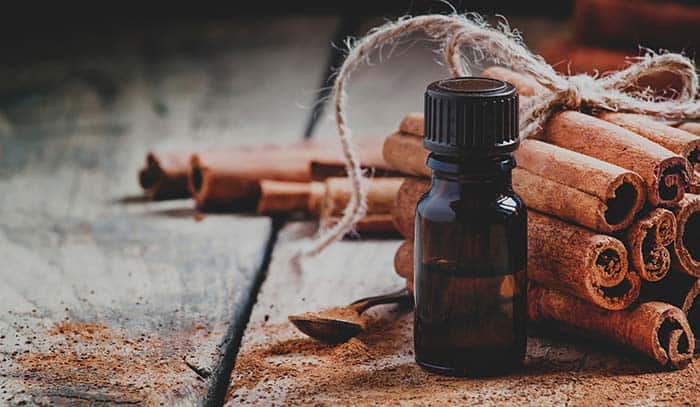
Spicy, warming oil used by the ancient Egyptians as an aromatic foot massage. Energising and stimulating with antiseptic properties and a potent and quite wonderful aroma, this essential oils is considered to be an EXTREMELY dermotoxic oil (careful with the area around your eyes when handling this oil!). Cinnamon EO can give you a warm up feeling by simply smelling it. This fact alone shows the potency in the liquid; these type of oils can literally stimulate your metabolism in an instant.
[Not to be confused with Chinese cinnamon (Cinnamomum cassia) which is used in similar ways. Cassia is also used medicinally mainly for colic, nausea, digestive complaints on other ailments.]
Details
- Botanical Name: Cinnamomum cecidodaphne
- Family: Lauraceae
- Note: Base to Middle
- Odour: Spicy, like resin, woody, camphorous
- Blends Well With: Other spice oils like clove, basil, ginger, fennel, marjoram.
Benefits
BODY
- A warming oil, can bring relief to the body soothing aches
- Good to restore comfort to tired joints and muscles, helps boost circulation to the extremities
- Effective at reviving joints that are sore and aggravated by damp or cold weather
- Aids digestion, relieves constipation, has antispasmodic action that calms cramps, spams and stomach
- Antiseptic, effective against parasites, viruses and bacteria (especially scabies and lice)
- Aids the body to prepare to heal
MIND
- In a diffuser it helps energise the mind
- Lifts flagging spirits, counters depression and exhaustion
- Can inspire creativity
OTHER
- Cinnamon bark stimulates appetite
- An exotic spice that can be used to create a sensual environment
- As a spice, cinnamon is a digestive tonic and also used to add flavour to meals
- A lovely addition to any essential oil blend that wants to evoke a Christmas feel
- It may curb blood sugar by lowering insulin resistance (source)
Safety
Cinnamon oil is really dermotoxic and can be extremely irritant and produce burning sensation so it you should only be used it in very low concentration, at less than 0.5% when mixing with a base oil. Even when diluted you need to be careful near eyes or any delicate area like mucous membranes. You can use cinnamon leaf oil (not bark) on the skin. Never take cinnamon essential oil internally.
How to Use this Essential on Its Own
MASSAGE
- Stimulate circulation: Massage over the abdomen area to stimulate circulation
FOOT BATH
- Relaxing foot bath: 3 or 4 drops to warm water to relax your feet
DIFFUSER
- Disinfect air: 2 drops to disinfect air, i.e. in a sick room or to get rid of bad smells
Essential Oil Blends Recipes
MASSAGE
- For your feet: Half an ounce (1/2oz) your chosen carrier oil, 3 drops clove EO, 3 drops lemon EO, 2 drops cinnamon EO, 1 drop rosemary EO, 1 drop eucalyptus EO.
- To relax muscles and body in general: 1 drop cinnamon EO in 1oz carrier oil like almond or for a lighter mix you can use grapeseed or fractionated coconut oil. Massage joints arms and legs.
DIFFUSER
- To relieve lung heaviness, relax and uplifting: Combine 1 drop cinnamon EO with 6 drops mandarin EO.
- For a sensual touch: 3 drops cinnamon EO, 3 drops ginger EO, 3 drops cedarwood EO, 3 drops vetiver EO.
ROOM SPRAY
- Room spray: 1 drp cinnamon EO, 3 drops clove EO, 3 drops cedarwood EO, 6 drops tea tree EO, 6 drops lemon EO. Mix all essential oils in 2 cups of water and shake well before use.
OTHER IDEAS
- Add to the essential oils for respiratory congestion blends to enhance their antimicrobial properties. Choose from Oregano EO, clove EO, thyme EO, tulsi EO and cinnamon EO.
Where to Buy Cinnamon Bark EO
I’m not supporting a particular brand, do check different brands to see which one is the right one for you. I buy most of my essential oils from a private British supplier but if you’re in the US below is the one I would choose for myself:
[amazon box=”B00UICKAUA”]
2 Ginger Root Essential Oil

Ginger is the go-to remedy when for digestive problems as it is a soothing oil. It is also a great stimulant and a good at supporting mind and body. If you’ve smelled ginger root (isn’t it lovely?!) you’ll recognise it is wonderfully sweet, spicy, pungent and fresh.
Ginger EO is a hot oil known as effective at relieving travel sickness nausea as well as pregnancy nausea. I suffer from travel sickness myself (badly) but have never used it for this – I must give it a try! Ginger EO is also very useful as an antiseptic when we have a cold or the flu including having analgesic properties that can help ease soreness of the muscles as well as tension headaches.
The essential warming property of gingerol, the active ingredient of ginger root, makes it ideal for digestive support. The essential oil can be topically applied in highly diluted form over the abdomen in a compress. (Source)
Details
- Botanical Name: Zingiber officinale
- Family: Zingiberaceae
- Consistency: Thin to mildly viscous
- Note: Middle to base
- Odour: Balsamic-woody, sharp, warm, peppery, spicy
- Blends Well With: Citrus oils and spice oils
Benefits
- Fresh ginger has a chemical compound known as gingerol, an active ingredient with many benefits
- A hot oil like ginger eases digestion with a calming effect on the digestive system, settles digestion caused by overeating or stress
- Restorative tonic to enhance vitality to the body (revitalises energy, good if you’re feeling down or exhausted, reviving a tired mind, helping lift feelings of mental fatigue or confusion)
- Antiseptic and pain-relieving: inhaled and/or diffused it can help decongest heaviness in lungs, helping to combat colds, ward off viruses or sooth pain when a cold has set in
- It can sooth the discomfort of sore throats
- Relieves muscles ache when applied locally boosting circulation and providing warmth easing discomfort of tired and sore muscles
- This hot oil is anti-inflammatory and analgesic, relieves migraines and headaches
- Ginger EO clears stagnant energy in the system
- Ginger is a hot oil that’s beneficial for the heart
Safety
Non-toxic, non-irritant in dilution (except in high concentration), slightly phototoxic. Avoid face and neck. Dilute at 0.5% with a base oil. Never take internally.
How to Use this Essential on Its Own
- Sore throats: 2 drops of ginger EO to 1 tsp vodka and dilute with some hot water. Wait for it to cool and use as a gargle.
- Migraines/Headaches/Nausea: 2 drops ginger EO with 1 tsp carrier oil of your choice. Massage gently into pulse points as well as temples.
- Digestive balance: 1 drop of ginger EO applied to a cotton ball or a tissue will help support digestive balance or discomfort.
- Digestive support: Dilute at 0.5% with your chosen carrier oil and place in a compress over the abdomen.
Essential Oil Blends – Recipes
MASSAGE
- Massage blend: Mix 30ml carrier oil with 4 drops ginger EO, 5 drops peppermint EO, 5 drops eucalyptus globulus EO
- Digestion balance: 4 drops ginger EO, 9 drops peppermint EO, 7 drops grapefruit EO, 3 drops nutmeg EO, 3 drops sweet fennel EO in 30ml carrier oil
BATH
- Soothing an upset stomach: 1 drop ginger EO and 2 drops chamomile EO to a warm bath
DIFFUSER
- To ease lungs and breathing: 5 drops ginger EO, 4 drops cardamom EO, 2 drops thyme EO
DIRECT PALM INHALATION
- To boost energy & enhance wellbeing: 1 drop ginger EO, 1 drop bergamot EO
Where to Buy Ginger EO
I’m not supporting a particular brand, do check different brands to see which one is the right one for you. I buy most of my essential oils from a private British supplier but if you’re in the US below is the one I would choose for myself:
[amazon box=”B07NZ2SW2X”]
3 Clove Bud Essential Oil
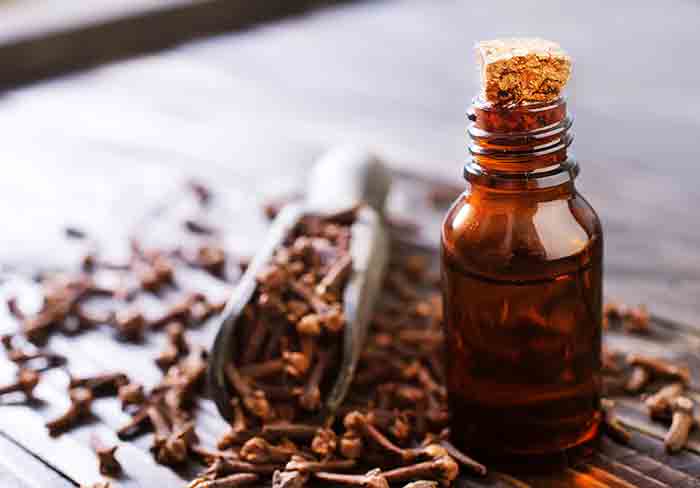
As we know, the bud is widely used as an aromatic spice in cuisine. The tincture has been used for digestive upsets and to ease tooth pain, while the tea has been used to relieve nausea. The oil is warming and can be used in small amounts to add analgesic and antiseptic properties being useful as a mouth for oral infections.
Note: This essential oil can be distilled from the leaves, buds and stems/stalks. The bud has 60 to 90% eugenol, caryophyllene and eugenyl acetate (the leaf 82-88% eugenol and the steam 90-95% eugenol but only clove bud oil is apt for aromatherapy and home use). Here we will be talking about the oil extracted from the bud as it’s the one that can be used for aromatherapy.
Details
- Botanical Name: Syzygium aromaticum
- Family: Myrtaceae
- Consistency: Pale yellow liquid
- Note: Top note
- Odour: Sweet and spicy, fruity fresh
- Blends Well With: Lavender, rose, bergamot, bay leaf, lavandin, clary sage, ylang ylang, allspice
Benefits
- Gums and teeth: helps fight the germs that cause bad breath, relieves toothache and swollen gums
- Digestive system: Helps with nausea and colic (the tea also helps with this)
- Muscles/Joints: Can help with arthritis, rheumatism, sprains, circulation, soothes muscles, eases joints
- Respiratory system: Can help ease asthma, bronchitis, coughs, sinusitis
- Immune system: Flu and cold
- Room scent: it clear and disinfects the air
Safety
Use safely by diluting very well at less than 0.5%. Avoid on hypersensitive or damaged skin. Avoid on children under seven years old. Can cause mucouas membrane and skin irritation and may cause dermatitis.
How to Use
MASSAGE
- To ease joints/muscles ache: 3 drops clove EO to 1 tablespoon base oil (almond oil for a denser mix or fractionated coconut oil for a light mix). Rub affected area.
DIFFUSER
- To disinfect air: 3 drops clove EO in your diffuser
OTHER
- Add to the essential oils for respiratory congestion blends to enhance their antimicrobial properties. Choose from Oregano EO, clove EO, thyme EO, tulsi EO and cinnamon EO.
Recipes
- Winter and holiday feel blend 1: 4 drops cinnamon EO, 3 drops sweet orange EO 2 drops clove EO
- Winter and holiday feel blend 2: 4 drops orange EO, 4 drops ginger EO, 3 drops cinnamon EO, 3 drops clove EO – optional: 4 drops mandarin or tangerine EO
Where to Buy Clove Bud EO
I’m not supporting a particular brand, do check different brands to see which one is the right one for you. I buy most of my essential oils from a private British supplier but if you’re in the US below is the one I would choose for myself:
[amazon box=”B007P70U10″]
4 Cardamom Pod Essential Oil
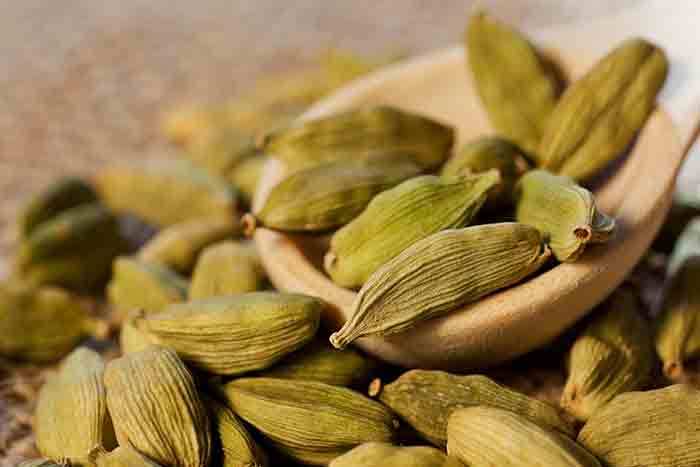
A member of the ginger family, cardamom essential oil is rich and exotic, luxuriously smooth with an exquisite scent. Warming, sensual and intoxicating, this essential oil is a must if you’re creating an aphrodisiac blend. A natural diuretic as well as a digestive stimulant boosting metabolism. An effective antiseptic.
Details
- Botanical Name: Elettaria cardamomum
- Family: Zingiberaceae
- Note: Middle
- Odour, spicy, balsamic, floral tones, woody tones, slightly camphorous
- Blends Well With: Spice oils, bergamot, orange, cedarwood and rose
Benefits
- Mind and emotions: Promotes emotional balance, also calms the mind, improves concentration, reduces drowsiness, grounding properties,
- Stress: Combats tiredness, stress and fatigue
- For detoxing (massage): When diluted with a base oil massage to help boost circulation
- Digestion: Calming action can help ease nausea and an upset stomach
- Teeth and gums: With antiseptic properties which are useful for treating bleeding gums and bad breath
- Skin care: A gentle oil that can be part of your massage oil blends for most skin types and a great component of natural mouthwashes and natural deodorants (helps eliminate bacteria that causes body odour)
Safety
Cardamom oil is non-toxic, non-irritant and non-sensitising. Avoid use on sensitive skin. Avoid using in children under seven years old. Do not take cardamom essential oil internally.
How to Use
MASSAGE (Cardamon EO shines when it comes to massage oils because of its aroma and soothing properties)
- Sooth an upset body and mind and to generally detoxify and refresh: 8 drops to 2 tablespoons base oil like sweet almond oil to work as a sensual massage oil and lovely warming tonic with a delightful aroma.
MOUTH
- Mouthwash mix: 2 drops in a teaspoon of glycerine and mix with water for a mouthwash
DIFFUSER
- In the Diffuser: Cardamom can be used any time you would like to enhance a diffuser blend with the qualities of warm, soothing spice. Like other spices this oil will help to open the breath and relieve heaviness and lung discomfort.
- Cardamom has strong calming and grounding properties, promoting emotional equilibrium when diffused or used in direct palm inhalation.
Essential Oil Blends – Recipes
MASSAGE
- Sooth stomach discomfort or ache: Combine 30ml carrier oil with 6 drops clary sage EO, 4 drops cardamom EO, 4 drops roman chamomile EO, 4 drops angelica EO
DIFFUSER
- For romance: Combine 15ml carrier oil with 4 drops jasmine EO, 4 drops sandalwood EO, 2 drops cardamom EO, 2 drops rose EO
PERFUMERY/AROMATIC VALUE
- Perfumery: Cardamom is a warm, sweet, floral spice which lends very well to blending. It has everything you could look for in the exotic spice department! Mix some with your rose and sandalwood for a truly sensual perfume.
Where to Buy Cardamom Pod EO
I’m not supporting a particular brand, do check different brands to see which one is the right one for you. I buy most of my essential oils from a private British supplier but if you’re in the US below is the one I would choose for myself:
[amazon box=”B07NZ2JHPF”]
B) The Hot Oils: Mediterranean Kitchen Herbs
Pertaining to the Lamiaceae family (Lamiaceae, formerly called Labiatae, the mint family of flowering plants, with 236 genera and more than 7,000 species, the largest family of the order Lamiale – source), which has the largest number of species and varieties. Included are: sage, rosemary, basil, oregano and thyme. The list is endless but here we’ll cover the must essential oils and their benefits. Note that even if you only have a few of these herbaceous oils it can be said you have a full pharmacy at your disposal at home. So cool.
There are hot herbaceous spices and less hot or warm/cool. An example of a hot herbaceous spice would be oregano. An example of a warm/cool herbaceous spice would be fennel.
The below are my top choices for kitchen herbs in the form of oils.
1 Tulsi Essential Oil (Holy Basil)

Ah, the Holy Basil plant, also known as the Queen of Herbs! I definitely must get seeds to grow in La Finca. Tulsi has been revered in India for thousands of years, and, believe it or not, there are are around 64 varieties of it. In India this adaptogenic is the number 1 choice for fever. A very powerful aromatic herb that is used extensively in Ayurvedic medicine because of its incredible therapeutic benefits. Make sure to have this powerful essential in your medicine kit at home.
With an uplifting nature, Tulsi means ‘the incomparable one’. It boosts your energy levels and is a safe essential that can be used in your diffuser together with the respiratory oils. It is very good for purifying the atmosphere and is also ‘protective’ of the home.
This aromatic essential jewel should belong in every essential hot oil collection. With such an inviting aroma Tulsi EO is a diffuser staple.
Details
- Botanical Name: Ocimum sanctum
- Family: Lamiaceae
- Note: Middle or top note
- Odour: Sweet and spicy, fresh, camphorous, sharp, herbaceous-minty oil, warm, a touch of clove accent
- Blends Well With: Citrus oils and floral oils
Benefits
- The best essential oil for treating asthma
- Number 1 oil in India to treat fever
- Helps you cope with stress.
- Strengths brain function
- Good for respiratory system in general
- Promotes vitality for the household when diffused
- Good for children when suffering from congestion
- Uplifts and clarifies
- Spiritually considered a purifying oil
Safety
Dilute at 0.5% or less with a base oil. Non-toxic and non-sensitising when properly diluted. Do not use if pregnant. Do not use if susceptible to epilepsy. Do not use on children under two years. Do not take internally.
How to Use
DIFFUSER
- To purify air: A few drops in your diffuser
Blends
DIFFUSER
- Purifying blend 1, sweet note: 4 drops tulsi EO, 3 drops eucalyptus EO, 2 drops pine EO
- Purifying blend 2, citrus note: 4 drops tulsi EO, 4 drops clary sage EO
OTHER
- Add to the essential oils for respiratory congestion blends to enhance their antimicrobial properties. Choose from Oregano EO, clove EO, thyme EO, tulsi EO and cinnamon EO.
Where to Buy Tulsi EO
I’m not supporting a particular brand, do check different brands to see which one is the right one for you. I buy most of my essential oils from a private British supplier but if you’re in the US below is the one I would choose for myself:
[amazon box=”B07GVRVL2D”]
2 Sweet Fennel Essential Oil
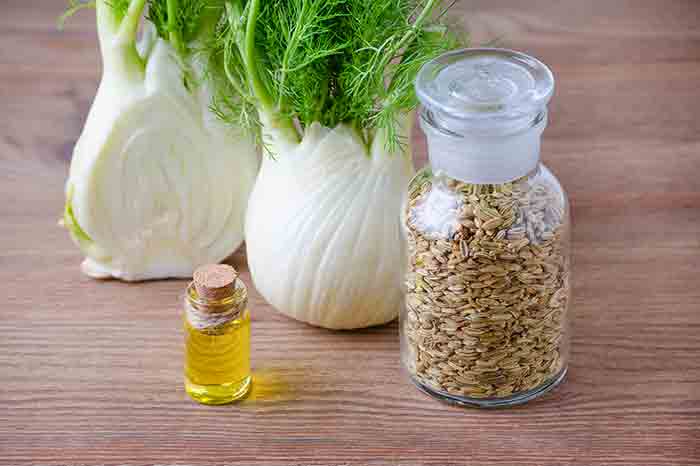
This is an effective and truly versatile essential oil with a lovely aroma. Cooling and cleansing its main action is to unblock. I use it for my DIY eye contour cream, at a really low percentage, obviously. Sweet fennel essential oil is great for skin care in general as it is astringent and suitable for mature skin. It helps balance oily skin as well as dry skin and is suitable for most skin types (and helpful when the skin shows problems – i.e. redness).
Details
- Botanical Name: Foeniculum vulgare
- Family: Apiaceae/Umbelliferae
- Note: Middle to top
- Odour: Fresh, sweet, anise, warm, clean, earthy
- Blends Well With: Citrus oils, floral oils
Benefits
GENERAL
- Eases digestive disorders; a massage blend helps relieve digestive craps, constipation, flatulence and bloating. It can stimulate appetite and brings relief to nervous indigestion.
- Has a diuretic effect aiding detox
- Helps stimulate circulation (can provide a great detoxifying massage)
- Can be used to work on cellulite
- Good for gargles in a mouthwash to fight bacteria that causes bad breath and tooth decay
- A mild expectorant that fights colds, eases respiratory congestion and loosens phlegmy coughs. Prepare a blend to rub chest area or use in your diffuser
- Soothes body and mind
SKIN CARE
- Astringent
- Suitable for all skin types
- Suitable for mature skin
- Balances oily skin
- Helps with dry skin
- Helpful for troubled skin
Safety
Sweet fennel oil is non-toxic and non-sensitizing, dilute at less than 2%. May cause mild skin irritation. Avoid using during pregnancy, breast-feeding mothers should also avoid, and in cases of epilepsy and estrogen-linked cancers avoid as well. Not suitable for children under seven. Do not take sweet fennel essential oil internally.
How to Use
MASSAGE
- As a massage oil in general to encourage feelings of comfort and wellbeing
- As a massage oil for indigestion combine 6 drops of sweet fennel EO with 1 tablespoon carrier oil. Application: massage abdomen area in a clockwise direction
- As a massage oil to rub into stressed muscles or overworked joints
MOUTH
- In a mouthwash: 2 drops sweet fennel EO in a teaspoon of glycerine, add to water and use as mouthwash
BATH
- Add a few drops to a warm bath to boost energy, vitality and to uplift if feeling upset or under the weather
- Add a few drops to a warm bath to support stomach health
SKIN CARE
- Oily skin? Add 2 or 3 drops to your facial cream tub and mix well
DIFFUSER
- Planning a party? Don’t forget to add sweet fennel EO into your diffuser for a lovely, warming, inviting effect
- In a diffuser to encourage appetite and cheer up your home
OTHER
- Use as a booster to with different EO blends to enhance their aromatic properties as well as their therapeutic benefits
Recipes
MASSAGE
- Women’s lower abdomen area: 2 drops fennel EO, 2 drops clary sage EO, 2 drops bergamot EO, 2 drops rose EO, 2 drops neroli EO in 15ml base oil of your choice. Application: massage over lower abdomen area
- To support soul choices: 5 drops sweet fennel EO, 5 drops clary sage EO, 3 drops geranium EO, 1 drop melissa EO mixed in 15ml base oil of your choice
COMPRESS
- Women’s lower abdomen area: 2 drops fennel EO, 2 drops clary sage EO, 2 drops bergamot EO, 2 drops rose EO, 2 drops neroli EO in 15ml carrier oil of your choice and apply over lower abdomen area with compress
- To support stomach health 1: Mix sweet fennel EO with cardamom EO to make a compress, apply over abdomen area
- To support stomach health 2: 4 drops sweet fennel EO, 3 drops peppermint EO, 3 drops ginger EO, 1 drop nutmeg EO in 15ml your chosen carrier oil. Apply over the abdomen area.
DIFFUSER
- When entertaining guests: Sweet fennel EO, rose EO and orange EO for a lovely diffuser blend
- To support soul choices: 5 drops sweet fennel EO, 5 drops clary sage EO, 3 drops geranium EO, 1 drop melissa EO into your diffuser
Where to Buy Sweet Fennel EO
I’m not supporting a particular brand, do check different brands to see which one is the right one for you. I buy most of my essential oils from a private British supplier but if you’re in the US below is the one I would choose for myself:
[amazon box=”B0069SQJ52″]
3 Oregano Essential Oil
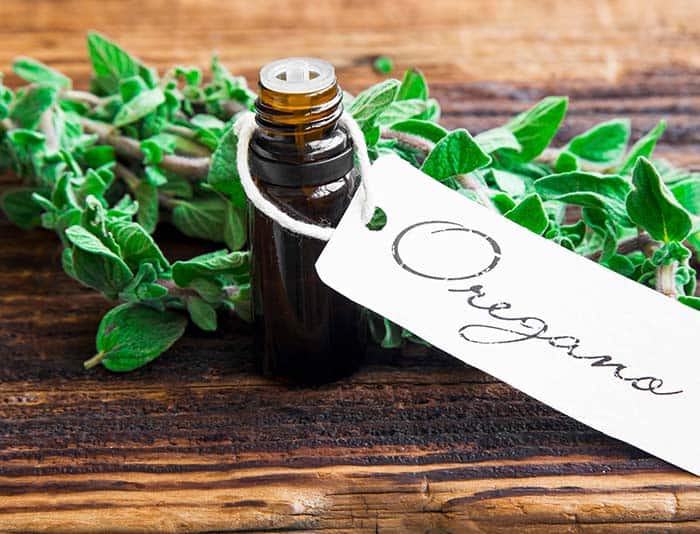
Powerful antibacterial, great for treating indigestion, diarrhoea, rheumatism, earaches, insect bites and coughs. Great for diverse health complaints.
Details
- Botanical Name: Origanum heraclioticum
- Family: Labiatae
- Note: Middle
- Odour: Spicy, camphoraceous, warm, herbaceous
- Blends Well With: Conifer, wood, florals and herbs
Benefits
- Great purifying qualities
- Boosts immunity, antibacterial action
- Helps relieve urinary tract infection
- Helps fight fungal infections
- Supports respiratory function, clears sinuses
- Helps ease the production of mucus
- Helps reduce airborne pathogens
- Increases anti-microbial powers
- Helps regulate menstruation relieving menstrual cramps (and other abdominal pains)
Safety
Use at less than 1% dilution. Due to its thymol content never apply oregano EO on skin or on mucous membranes. Avoid using during pregnancy and when breastfeeding. Don’t use in children under seven years old. Do not take internally.
How to Use
MOUTH
- Tooth and mouth health: 1 drop oregano EO in a glass of water and use as mouthwash.
MASSAGE
- To enhance immunity: Diluted at 1% or less with your chosen carrier oil. Massage to enhance immunity
- To enhance circulation: Dilute at 1% or less with your chosen base oil. Massage to enhance circulation on head and sinuses, mouth and skin.
BATH
- To strengthen immune system and support digestion: Add 1 or 2 drops to a warm bath.
DIFFUSER
- To ease congestion: 2 to 4 drops into your diffuser during the winter or flu and cold season will enhance and give strength to your respiratory system.
CLEANER/DISINFECTANT
- To purify surfaces: Add a few drops oregano EO to a spray or squirt bottle and use to purify surfaces (don’t use over wood).
- Antibacterial handwash: Add 10 drops to a liquid soap (preferably unscented) for a fantastic antibacterial handwash.
OTHER
- Add to the essential oils for respiratory congestion blends to enhance their antimicrobial properties. Choose from Oregano EO, clove EO, thyme EO, tulsi EO and cinnamon EO.
Blends
DIFFUSER
- To ease congestion: 9 drops drops ravensare EO, 4 drops oregano EO, 3 drops thyme EO, 3 drops rosewood EO. ravensare oil, 3 drops oregano oil, 3 drops thyme oil and 3 drops rosewood oil.
OTHER
- Blending the different essential oil groups: 10 parts essential oils for respiratory congestion, 5 parts essential oils for immune boosting (antimicrobial EOs), 2 parts spice oils (the ones mentioned on this post). This will help boost your blend with all the different properties. By keeping the kits at home (respiratory oils, immune system oils, spice/hot oils, flower oils, etc) you’ll have the essentials you’ll need which means a lovely variety of oilsto work with.
Where to Buy Oregano EO
I’m not supporting a particular brand or particular products, so please do check different brands to see which one is the right one for you. I buy most of my essential oils from a private British supplier but if you’re in the US below is the one I would choose for myself:
[amazon box=”B00PM8TKSI”]
The Complete list of Hot Essential Oils
I hope I’ve answered above your ‘what are hot essential oils’ question which I’ve tried to do to the best of my abilities. Just to say that even though I covered these hot oils and warm oils the list is a lot longer. When it comes to your health you can really choose between so many different essential oils, the hot oils being one of the groups that can benefit us greatly.
There are many DIY home remedies you can create with these oils (always being careful as hot oils can be extremely dermotoxic and cause burning sensation and dermatitis) and I personally would love to have the list at hand as it will help me greatly when it comes to creating my own DIY blends.
Use the below as a guide only.
Complete list of Spice Essential Oils
- Allspice
- Anise
- Anise, star (Illicum verum)
- Black Pepper (Piper nigrum)
- Cardamon (Elettaria cardamomum)
- Cassia
- Cinnamon Cassia (Cinnamomum cassia)
- Cinnamon (Cinnamomum zeylanicum)
- Cumin
- Clove (Syzgium aromaticum)
- Ginger (Zingiber officinalis)
- Ho Leaf (Cinnamomum camphora)
- Nutmeg (Myristica fragrans)
Complete List of Herbs Essential Oils
- Basil (Ocimum basilicum)
- Bay Laurel (Laurus nobilis)
- Bergamot (Citrus bergamia)
- Cajeput (Melaleuca cajeputi)
- Citronella (Cymbopogon nardus)
- Clary Sage (Salvia sclarea)
- Coriander (Coriandrum sativium)
- Dill
- Fennel, Sweet (Foeniculum dulce)
- Hyssop (Hyssopus officinalis)
- Lemongrass (Cymbopogon citratus)
- Marjoram, Spanish (Thymus mastichina)
- Marjoram, Sweet (Origanum marjorana)
- Melissa/Lemon Balm (Melissa officinalis)
- Oregano (Origanum heraclioticum)
- Palmarosa (Cymbopogon martinii)
- Peppermint (Mentha piperita)
- Rosemary (Rosmarinus officinalis)
- Sage, Clary
- Sage, Common (Salvia officinalis)
- Sage, Dalmation
- Sage, Spanish
- Thyme (Thymus vulgaris)
- Tulsi (Holy Basil) (Ocimum sanctum)
One request?
I’ve put so much effort writing this blog post to provide value to the blogging community. It’ll be very helpful for me if you consider sharing it on social media networks.
SHARING IS ♥️
Helpful Resources
About Gingerol
About Eugenol
How to Use Spicy Essential Oils Safely
